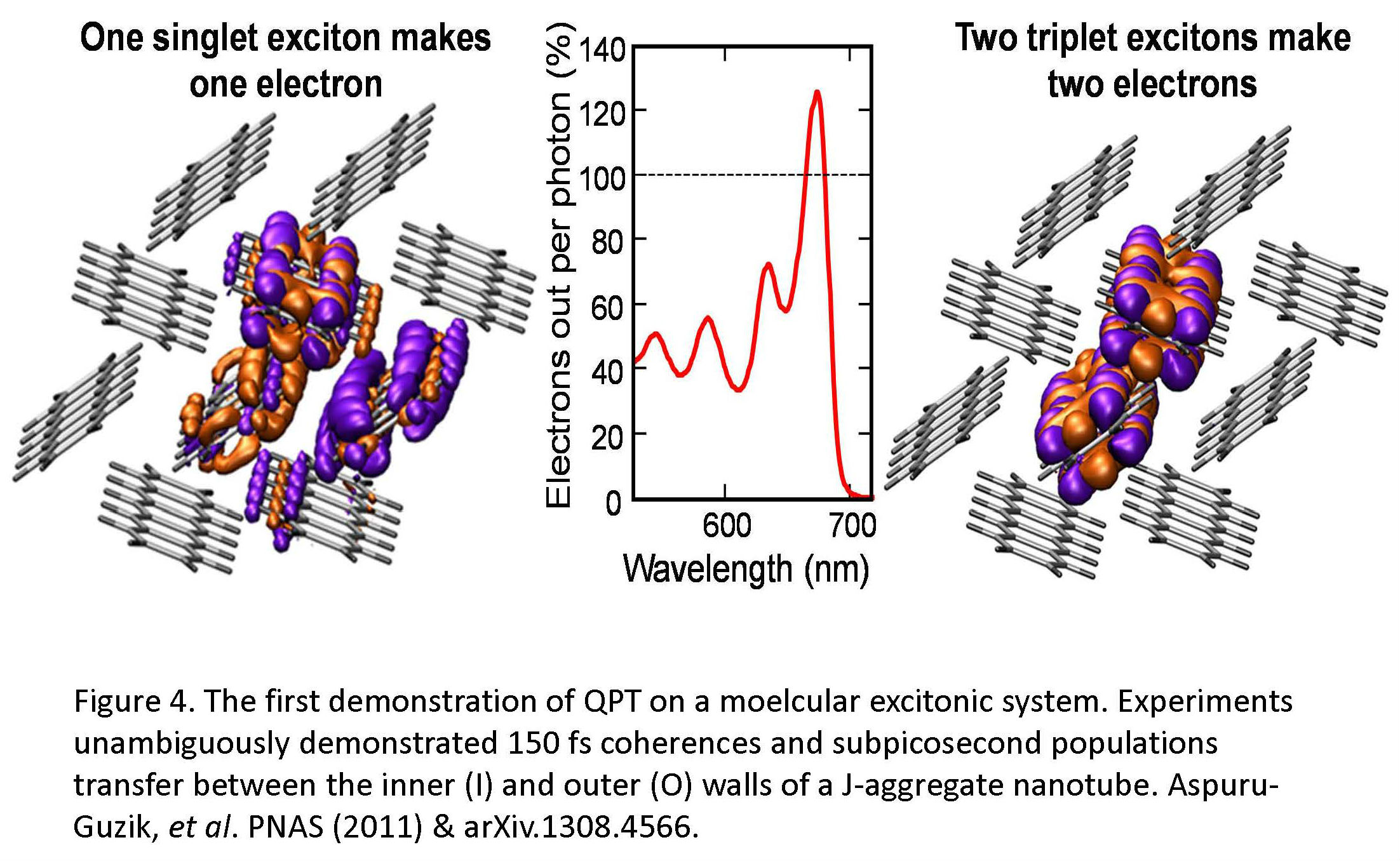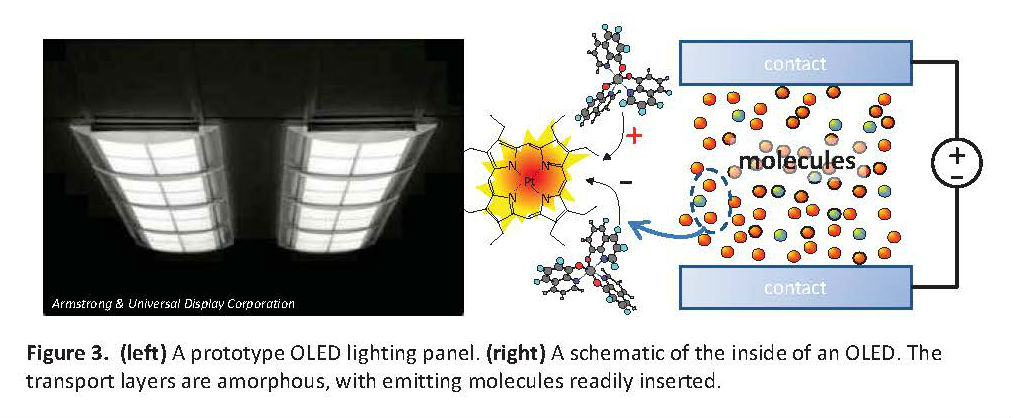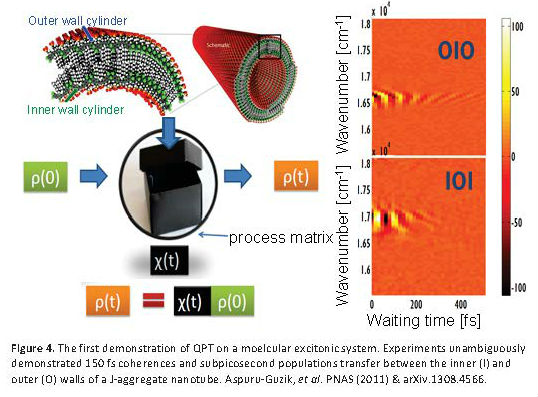Projects - MIT-Harvard Center for Excitonics
Exciton – a quasiparticle excitation consisting of a bound electron and hole that mediates the absorption and emission of light, especially in disordered and low-dimensional materials.
We seek to supersede traditional electronics with devices that use excitons to mediate the flow of energy. Mastering the properties of excitons offers the ability to guide energy at the nanoscale, and transform it with a flexibility that is impossible in conventional systems. For example, within the center, we have exploited the flexibility of excitonic transformations using singlet exciton fission to generate multiple carriers in a solar cell at an efficiency of > 1.26 electrons per photon, exceeding the unity limit in conventional electronic materials.
Team 1: Multiple Carrier Excitonics for Solar Cells
PIs: Bawendi, Dauler, Englund, Bulović, Van Voorhis, Baldo, Jarillo-Herrero, Levitov & Tisdale
Singlet exciton fission is one focus of our fundamental studies of exciton splitting in different materials. In conventional nanocrystalline semiconductors, Bawendi and Dauler have performed extensive single molecule spectroscopy showing that excitation of secondary electrons must out-compete rapid thermalization losses. But in molecules, Baldo and Van Voorhis demonstrated that these losses are spin disallowed, meaning that exciton fission can be almost perfectly efficient. Graphene is a third, and special case. Prior work by Jarillo-Herrero and Levitov demonstrated that graphene may be capable of generating ~ 10 carriers per photon if the hot carriers can be extracted in time.
This team’s continuing focus is dynamics in states of multiple excitations. We will pursue two collaborative projects that build on our prior work: multiexcitons and charging in semiconductor nanocrystals, and sensitized triplet transfer for singlet exciton fission. We will also introduce a new project: hot carriers in graphene.
Team 2: High Density Excitonics for Solid State Lighting
PIs: Baldo, Jarillo-Herrero, Kong, Bulović, Tisdale, Englund, Van Voorhis, Gradečak, Stach, Nelson
The focus of Team 2 is the second general advantage of excitonic materials: ease of fabrication. Given the dramatic reduction in manufacturing cost compared to conventional devices, it is notable that organic and quantum dot-based LEDs exhibit efficiencies just as large as conventional, crystalline LED materials. The catch is that organic and quantum dot-based LEDs cannot be driven to high brightness like conventional LEDs. This is the problem of ‘high density excitonics’. This team will pursue three approaches to high brightness LEDs. Baldo, Bulovic and Van Voorhis will work on OLEDs with short exciton lifetimes. Bulovic, Bawendi, and Tisdale will reduce losses in QD-LEDs, and Jarillo-Herrero and Kong will work with the other LED groups to introduce a new class of LEDs based on 2d materials, notably WSe2. We will also use a wide-field, spin-based technique developed by Englund to map excitons and charges in disordered materials. Several complementary non-destructive spectroscopic and structural characterization techniques developed by Gradecak with nano- and atomic-scale resolution will be used to directly correlate structure and optical properties of disordered materials. In collaboration with BNL (Stach), these results will be compared with the state of the art commercial semiconductor LED structures.
Team 3: Quantum Excitonic Transport
PIs: Aspuru-Guzik, Nelson, Baldo, Black, Dinca, Levitov, Jarillo-Herrero
Photosynthesis is the best example of the benefits of excitons in a practical, nanostructured system. Like our devices, photosynthesis exploits excitons and exhibits much larger levels of long range disorder than conventional solar cells. Indeed, this team was partly motivated by recent ultrafast experiments on the excitonic properties of photosynthetic complexes. To aid in the interpretation of these measurements, the Aspuru-Guzik group proposed an experimental protocol to systematically characterize both coherent and dissipative processes at the level of the evolving quantum state of the probed chromophores. In collaboration with postdoc Joel Yuen-Zhou, and the Bawendi and Aspuru-Guzik groups, Nelson performed the first experimental QPT in a “warm” and complex system, using double-walled J-aggregate nanotubes.
The QPT technique will be the basis of our ongoing research efforts in quantum transport. Notably, we plan to extend our spectroscopic capabilities and build the first entangled 2d Fourier Transform Spectroscopy tool, which should enable us to significantly reduce the optical power required to probe exciton interactions in new samples, such as the covalent organic frameworks made by Dinca and characterized by Black, or the valley coherences in WSe2 studied by Levitov and Jarillo-Herrero. We will also exploit our control over exciton coherence to improve exciton transport without the manufacturing challenge and expense of removing disorder using “topological excitonics”.










